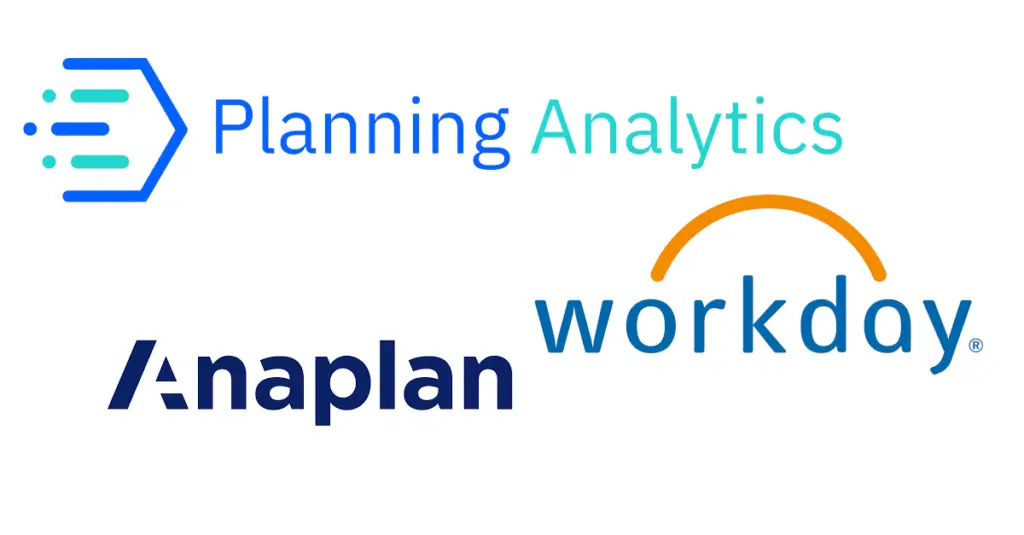
Jackie Twigge, November 4, 2024
Get the Best Solution for
Your Business Today!
Whether you’re a small business or a large enterprise, when it comes to planning for your organization’s success in an unpredictable world that is data-driven, chances are that you have outgrown Excel spreadsheets and are looking for an extended planning and analysis (xP&A) software solution such as IBM Planning Analytics with Watson, Anaplan or Workday Adaptive Planning.
Table of Contents
Signs that your organization is ready to switch to an xP&A software solution include
- Data volume: Over time, your data has grown, and your spreadsheets can’t handle the volume of data.
- Complexity: Your business processes have evolved and have become too complex to model in Excel.
- Performance: Spreadsheet performance has deteriorated over time, and you find yourself waiting a long time for spreadsheets to open, refresh, or recalculate.
- Accuracy: Your spreadsheets aren’t integrated with your other data sources, resulting in out-of-date data in often error-prone spreadsheets.
- Security: You need security controls to prevent unauthorized access to sensitive data and you need audit trails to track who changed what and when.
- Reporting: More reporting functionality is required than your spreadsheet reports can provide. You need the ability to slice and dice data for analysis and create ad hoc reports, with or without visualizations, on the fly.
- Collaboration: Spreadsheets are not meeting your organization’s requirement for finance and other business teams to easily collaborate and perform enterprise planning.
How can Extended Planning and Analysis (xP&A) software solutions help?
xP&A software helps organizations take control of their data and turn it into actionable insights by automating the process of data collection, modeling, analysis, and reporting. It can be used for a variety of purposes, such as financial planning and analysis, sales and marketing planning, operations planning, human resources planning, and supply chain planning.
Over the last decade or so, their capabilities have increased dramatically. Most modern xP&A software can now take advantage of in-memory, columnar and relational database technologies. They can employ predictive; statistical and decision modeling techniques and they can work with big data and data lakes to process and analyze large datasets.
This allows businesses to track progress, optimize resources and make better decisions, faster.
Selecting an Extended Planning and Analysis (xP&A) Software Solution
Choosing an xP&A software solution isn’t straightforward. There are many options available, but not all software is created equal and when it comes to choosing, there are various factors to consider such as:
- What are your needs for the software? If flexibility is needed, then you may want to choose a different software solution than if you needed software that is more user-friendly.
- What is your company’s size? If you have a large company, then you may want to choose software that is more scalable.
- What is your budget for the software? If you have a limited budget, then you may need to sacrifice functionality for cost.
- What is your company’s culture? If you have a company that is more traditional, then you may want to choose software that is more familiar to your employees.
Let’s have a closer look at some of the key features in IBM Planning Analytics with Watson, Anaplan, and Workday Adaptive Planning. The summary comparison of 7 key areas between the three technologies, is based on extensive experience in the subject matter of Financial Planning and Analytics, in-depth knowledge of IBM Planning Analytics with Watson and a theoretical understanding of Anaplan and Workday Adaptive.
Infrastructure Platforms
Whether your organization is ready to embrace the movement to the cloud or not, out of the three, IBM Planning Analytics with Watson will have you covered on all fronts. PA can be provided as a full SaaS offering, or as a traditional on-premise installation. Additionally, customers can elect to host the software on their own third-party cloud (Azure, AWS, etc). The software is the same across all platforms and applications can easily be migrated between platforms. This means customers can start on-premise and then move to the cloud once the organization is ready, without changing the technology of which the business has become accustomed.
Both Anaplan and Workday Adaptive were created as SaaS offerings and will likely always be cloud-native technologies only.
Data and Scalability
It is difficult to make a definitive statement about whether one tool is more scalable than another without more specific information about the environment in which it will be used.
From the start, IBM Planning Analytics with Watson was designed for enterprise planning and has always been hard to beat in terms of data scale because it handles sparsity so well. Its powerful calculation engine enables IBM Planning Analytics with Watson to handle very high volumes of data and still maintain the ability to do instant in-memory calculations for complex business models. It also is very flexible as models are custom built and business requirements determine the dimensionality of cubes (design isn’t limited by the capabilities of the engine).
Anaplan’s Classic Hyperblock calculation engine does not have the best reputation in terms of data scale when it comes to sparsity in the dataset. This natively dense engine was designed to perform well with datasets where most cells were populated. In a real-world environment, most datasets are not like this and are sparse, which presented challenges for the Classic engine. This in turn had an impact on how cubes were designed, which had a knock-on effect on the ability to perform consolidated reporting. But don’t discount Anaplan as an option yet. Anaplan is in the process of introducing a new calculation engine, Anaplan Polaris which is a natively sparse engine. Anaplan claims this engine will be more efficient at storing and calculating sparse datasets which in turn will result in greater dimensionality and granularity when modeling with sparse datasets.
Workday Adaptive Planning was designed for enterprise planning and is powered by their Elastic Hypercube Technology (EHT), a robust in-memory modeling engine that should allow large organizations to model, report, and analyze at any scale and complexity.
Modeling
In an enterprise-wide planning solution, modeling is used to create a representation of the business that can be used to make decisions and plan for the future. Since there are such a vast array of businesses and industries, these solutions need to be flexible to be able to deal with a variety of different types of situations.
One of the benefits of using IBM Planning Analytics with Watson is the flexibility to build the model from a clean slate. Tailored models can be built that meet the specific needs of the organization based on unique business requirements, processes, and rules.
Additionally, due to the powerful in-memory calculation engine, very complex business models can be built for planning at a granular level.
IBM Planning Analytics with Watson offers the option to follow a “Big Bang” implementation approach or a phased implementation approach where models can be built one at a time and then scaled when the organization and resources are ready to capture planning at a more granular level.
The models can be linked which allows a dynamic flow of data from model to model, and automatically aggregates contributions from all across the organization. For example, a retail organization might start with an income statement model and later decide to add a sales model to perform granular revenue planning using sales volumes at the product and customer level. Changes made to the planned sales volumes in the sales model will not only change the sales revenue within the sales model by customer and product but also the value of the sales revenue account in the income statement model will be updated. The same organization might later decide to add a demand model, to more effectively and efficiently plan for production and optimization.
The drawback of this level of flexibility is that IBM Planning Analytics with Watson doesn’t provide the “plug-and-play” convenience that prebuilt packaged options offer. This can however be mitigated if the selected implementation partner offers functional blueprints, with pre-built dimensions and cubes, which can be utilized to get a jump-start and solid foundation, without sacrificing down-the-line flexibility.
Both Anaplan and Workday Adaptive Planning offer “plug-and-play” convenience, but prebuilt packaged modules tend to be less flexible as they are designed to be used by a specific type of business. They provide a set of tools that allow users to adapt their experience to best fit their needs. The modules include the ability to customize the interface, add or remove features, and change the way data is presented.
When it comes to nesting multiple dimensions on columns or rows, Anaplan is limited to nesting only three dimensions, which will limit the granularity available in a module.
Workday Adaptive Planning has fairly limited flexibility because the product was originally built for human capital management, and later expanded to address the needs of the Office of Finance. This makes Adaptive a good choice for labor-intensive organizations. This however is slowly changing over time, and Adaptive is continuing to expand its capabilities and functionality.
Data Entry and Integration Options
A good planning platform will offer a range of options for importing and exporting data so that you can choose the most appropriate method for your needs.
With Planning Analytics with Watson you can:
- Manually capture data directly in the proprietary database via cube views or templates using the Excel or web interface. This is very useful when different planning contributors in your organization need to capture data variables in real time that instantly drive recalculated budgets and forecasts.
- Create multiple plan versions with sandbox functionality, which allows you to change projections and then review the effect on different areas within the organization before committing changes to the database. Manually upload data that already exists in spreadsheets directly to your Planning Analytics model using database send formulae.
- Automatically distribute numeric data to cells using built-in spread functionality. For example, you can use proportional spreading to distribute the projected sales volume of a new product being launched across a range of cells, based on data from a prior period for a similar product.
- Drag and drop a text file on a cube in IBM Planning Analytics Workspace which will automatically create a process that you can use to upload data from mapped columns in your text files to the relevant dimensions in the cube.
- Create processes using the ETL tool TurboIntegrator to automate data importation, metadata management, and other tasks from ODBC-compliant data sources, flat files, OLAP multi-dimensional sources, TM1 cube views, and TM1 dimension subsets.
- Export data, using TurboIntegrator processes in a format that can be read by other systems or push it directly to another system such as a data warehouse.
- Drill back into source systems, using TurboIntegrator processes, to view transactional-level data.
- Determine how often and when these processes execute using Chores, PA’s built-in scheduling functionality.
- Connect to other systems using the REST API.
All this functionality is native to IBM Planning Analytics with Watson at no additional software or license cost.
With Anaplan you can:
- Manually import flat files via a user interface.
- Use Anaplan Connect at no additional cost, to import and export data from flat files and relational databases. This tool is flexible, but it can be technically demanding and requires Batch and or Shell scripting knowledge and you will need to use scheduling software to automate processes.
- Use CloudWorks at no additional cost, to import and export data from cloud platforms such as AWS and Azure. This tool has a low technical barrier and allows for efficiency through scheduling and automation, but there appear to be limitations on the number of processes per Tenant and the size of individual files.
- Integrate with any type of software, provided there is an API available.
- Use Anaplan HyperConnect which acts as an ETL tool for both on-premise and cloud applications. This option will have an additional software cost implication in the form of either an Informatica Cloud license or HyperConnect itself.
- Use connectors to multiple third-party platforms such as MuleSoft, SnapLogic, Boomi, and One Cloud for integration, but this will come at a cost as these are paid options.
Overall, with Anaplan it appears you will be able to connect to multiple data sources using different tools, with or without additional cost implications or programming skills. To avoid performance degradation, the timing of large data transfers and bandwidth allocated to end-users will have to be considered. Access restrictions also have an impact on data import performance if you are not the Workspace administrator.
With the built-in integration framework of Workday Adaptive Planning you can:
- Import data from spreadsheets, with a limit of 100 columns.
- Import data and metadata from different data sources such as spreadsheets, databases, and cloud-based or on-premises systems.
- Filter, clean, map, and merge the data coming from different data sources.
- Set up data source connections for Adaptive Planning, JDBC-compliant databases, Microsoft Dynamics GP, NetSuite, Scripted data sources, Sage Intacct, Salesforce, Spreadsheet, Table groups, Union tables, Workday HCM, and Financials.
- Set up a Custom Cloud Data Source to connect to a web-accessible system authored in JavaScript using API, but an experienced JavaScript programmer is needed.
- Schedule tasks to automatically import data.
- Export data into a comma-separated value file, export a budget version into NetSuite using the NetSuite Integration option (if available), or use the Custom Cloud Loader in Integration to export to external cloud-based systems.
Workday’s built-in out-of-the-box integration tool will likely eliminate the need for any third-party integration tools, but there are cost implications to connect to some of the data sources. For a customer to import data from a NetSuite account, they will need to purchase the NetSuite Integration option.
Analysis and Reporting
What’s the point of importing all the data in the world using various methods and feeding it to complex budgeting, forecasting, and scenario planning business models, if it doesn’t provide the ability to properly and easily analyze and report on the results?
IBM Planning Analytics with Watson comes with easy-to-use presentation tools in the form of the Excel add-in Planning Analytics for Excel and the web interface Planning Analytics Workspace.
With the Excel add-in, customers can continue working in an Excel environment they are already familiar with while connecting directly to the same data source driven by the same centralized business rules. Highly formatted Excel templates for data capturing and management reporting can be designed in Excel once, after which parameters can be changed and data refreshed instantaneously for reporting. Another option is to break the live link and make a snapshot of the data in your report at a point in time. Users also have the added advantage of being able to access the same Excel template as a ‘web sheet’ in Planning Analytics Workspace.
In both interfaces, users can create ad-hoc reports on the fly and drill into more detail. In addition, Workspace provides a full browser-based dashboarding interface that allows users to create visually striking interactive dashboards.
Anaplan’s series 4 Excel Add-in can be used to access data from Anaplan modules in Microsoft Excel, but it does not look like Anaplan supports out-of-the-box reporting and visualization. Anaplan has what is called ‘purpose-built integrations’ for tools such as Tableau and Power BI, but this will have a cost implication if the organization isn’t already licensed to use either of these tools.
Workday Adaptive Planning reports are interactive and allow users to drill into detail and pivot data. It also comes with OfficeConnect, which connects Adaptive Planning databases with Microsoft Word, PowerPoint, and Excel for structured reports required for management packs and board meetings. Apparently, it does have some limitations though as reports aren’t easily modified once created, and report creation can be a slow process. Like PA, it also comes with web-based dashboarding functionality that allows the user to create visually striking interactive dashboards.
End User Experience
There isn’t a definitive answer to which of these tools is easier to use since it will depend on the specific needs and preferences of the user.
Most employees in a corporate environment will be familiar with Excel, and as all three tools have an Excel-Add in, it should be relatively easy for the end user to adopt either one. Planning Analytics appears to have the advantage here, as it has a two-decade record of supporting Excel as a primary interface and the functionality is very robust.
Further, the Planning Analytics with Watson user interface in either Excel or Workspace is very easy to use and provides self-service contribution, analysis, and dashboarding capabilities. Online help is available via IBM support, the IBM community, or IBM documentation, and both self-paced, as well as instructor-led training courses, are available.
Based on online reviews, the Anaplan interface is simple and very easy to use as well. The training material, which includes online help, downloadable guides, videos, and online courses, is designed to help customers quickly learn how to use the software. In performing research for this article, clear and detailed documentation for Anaplan was readily available.
Also based on online reviews, Workday Adaptive planning has an intuitive user interface that is easy to learn and user-friendly. The training material includes online support and documentation, tutorials, and instructor-led courses.
Licensing and Cost
Ultimately, there is no simple answer to the question ‘Which of these technologies is the most cost-efficient?’ This will vary depending on several factors, including the specific needs of the organization and the size of the deployment.
IBM Planning Analytics with Watson has flexible pricing options for the individual user or the entire user enterprise. Customers can purchase licenses for on-premise servers and users which include support and maintenance for the first year, after which there will be an annual support and maintenance fee. Alternatively, customers can sign up for a cloud subscription priced on a per-user, per-month basis.
Anaplan appears to have different pricing tiers with varying capabilities and is available as a yearly subscription. A customer initially buys a workspace of a particular size in memory. Multiple workspaces are available for purchase; however, the cost significantly increases as the size and complexity of the model increase.
Workday Adaptive Planning operates on a subscription-based business model. Pricing is based on the number of users and the amount of data stored. Pricing details for small and medium-sized businesses and enterprises are supplied only upon request.
When deciding between these three solutions, consider the total cost of ownership (TCO) which would include hidden costs like software training, customizations, hardware (if needed), maintenance & support, third-party software, and other related services.
Conclusion
In summary, any organization considering a planning solution should take a close examination of all platforms and reach their own conclusions as to what would work best in their environment, for their employees, based on their requirements.
As the weaknesses of software tools are often not apparent in quick demos that most customers see before buying a product, it is imperative to review third-party research comparing the strengths and weaknesses of the different tools. Ask for a POC using a sample set of customer-specific data when evaluating the tool and give employees the opportunity to play around with it. Alternatively, sign-up for a free trial and explore what functionality they have to offer.
Comments and feedback are encouraged if there are any important facts that have been omitted or misstated in this article on either of the tools discussed. Feedback from experienced consultants and implementers would be especially helpful so that the FP&A community can improve the comprehensive knowledge base of the platforms available.








